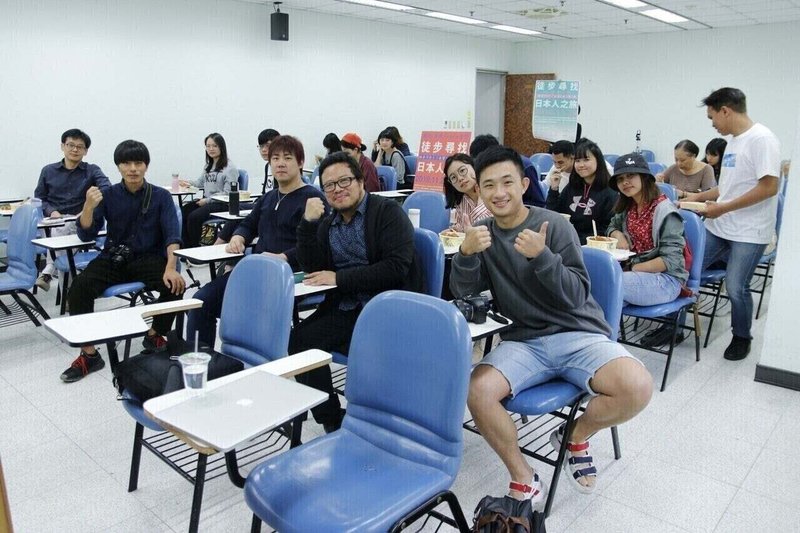
【第3回】台湾 桃園-新北 100km徒歩 「日本人探し旅」/ 3rd Taiwan Taoyuan-100km New Taipei "Japanese Search Trip"
2019年11月21日~23日、台湾の桃園市から新北市烏來までの約100kmを3日間で歩いた。その道のりは昔、日本政府と台湾原住民の領土の境界線だった。日本政府は台湾原住民の首狩りの文化を恐れ、境界線が敷かれたのだ。そこには、今でも日本と台湾の文化が混在し、特異な生活文化がある。歩きながらそれを写真と文章で記録し、台湾在住の日本人にインタビューも実施。その成果を国立政治大学の授業で大学生と共有した。
From November 21st to 23rd, 2019, I walked about 100km from Taoyuan City in Taiwan to Wulai in New Taipei City in 3 days. The journey used to be the border between the Japanese government and the territory of Taiwanese indigenous people. The Japanese government was afraid of the Taiwanese indigenous people's headhunting culture, and the border was laid. There is still a mixture of Japanese and Taiwanese cultures, and there is a unique lifestyle. While walking, I recorded it with photos and sentences, and interviewed Japanese people living in Taiwan. The results were shared with university students in a class at National Chengchi University.
▼歩いた道のりの概要
Overview of the way I walked

▼フライヤー Flyer
(by Yuria Kaneda)

プロジェクトの経緯
Project background
2019年夏、石川県加賀市で行われていた大学生のワークショップ「PLUS KAGA」で、徒歩の旅に関する発表をさせて頂いた。その時に、台湾の国立政治大学の教授であるメットさん(許阿赫)や陳さん(陳誼誠)が視察に来ており、その後の飲みの席で声をかけて頂いた。「ぜひ台湾でも徒歩の旅をやってみないか」というお話をいただき、今回の徒歩の旅を実施することになった。台湾にはUSRという大学院生や教授がテーマを持ち寄るグループがあり、スポンサーとして宿泊や食事の援助をして頂きながら徒歩の旅を実施できた。また、徒歩旅には全行程で通訳の方が同行した。
In the summer of 2019, I made a presentation about walking trips at the university student workshop "PLUS KAGA" held in Kaga City, Ishikawa Prefecture. At that time, Met and Chen, professors at National Chengchi University in Taiwan, came to visit and talked to me at the drinking table after that. We received a talking, "Why don't you take a walking trip in Taiwan?" And decided to carry out this walking trip. In Taiwan, there is a group called USR where graduate students and professors bring their themes, and as a sponsor, I could travel on foot with assistance in accommodation and meals.
In addition, an interpreter accompanied the entire journey on foot.
▼スタート地点/ 台湾桃園国際空港付近
Starting point / Near Taiwan Taoyuan International Airport

▼台湾在住の日本人にインタビュー(桃園大渓区)
Interview with a Japanese living in Taiwan (Taoyuan Daxi District)

▼ゴール地点 / 新北市烏來区烏来瀑布
Goal point / Wulai Falls, Wulai District, New Taipei City

スケジュール
Schedule
2019年11月21日 桃園市桃園国際空港-大渓区
2019年11月22日 桃園市大渓区-新北市新店区
2019年11月23日 新北市新店区-新北市烏來瀑布
合計 約93km
*イベントの日程
2019年11月21日 出発式 @源古本舖(台湾桃園市大渓区)
2019年11月25日 大学生向けの講義 @国立政治大学(台北市文山区)
▼大学生向けの講義の様子
Lecture for university students

実際に歩いて気づいたこと
What I noticed when I actually walked
台湾には日本の生活文化が様々な形で息づいていた。教育、言語、食事、会社、建築物...。台湾と日本の文化は混じり合い、今の暮らしが作られている。日本人が統治を行なったことは、領土や教育の問題で大きな軋轢があったものの、インフラ整備などでは恩恵を与えられていたようだ。
日本人インタビューの中で、台湾は極彩色を好むけど日本人は侘び寂びの感性から質素なものを好む傾向があるいう話を聞いた。道中たまたま極彩色の寺院やレストランのメニュー表を見かけたのでインタビューの話に納得がいき、写真を撮影した。また、歩いている途中で、路上に桜の花の絵が描かれており、そこから日本を連想できたこともあった。このように道中、様々な日本を感じる風景との出会いがあった。日本にいると気がつかない「日本」に出会えたのが、今回の企画だったと言える。異民族間の交流と共存について思いを巡らせることができた。
Japanese life culture was alive in Taiwan in various ways. Education, language, food, companies, buildings ... Taiwanese culture and Japanese culture are mixed to create the present life. The Japanese rule seemed to have benefited from infrastructure development, although there were major conflicts due to territorial and educational issues.
In an interview with Japanese people, I heard that Taiwan prefers colorful colors, but Japanese people tend to prefer simple things because of their sensibility of wabi-sabi. Along the way, I happened to see a menu table of colorful temples and restaurants, so I was convinced by the interview and took a picture. Also, while I was walking, a picture of cherry blossoms was drawn on the street, and I was able to associate it with Japan. In this way, along the way, I encountered various landscapes that felt Japan. It can be said that it was this project that I was able to meet "Japan" that I do not notice when I am in Japan. I was able to ponder the exchange and coexistence between different races.
メディア掲載
publication
・中央大学白門三七会広報紙
その他
その後の展開
Subsequent development
今回の徒歩の旅の大きな意義は、スポンサーが宿泊費、交通費、講演費などを支給してくれたことだ。自分にとっても自信になったし、大学生に向けて学びのきっかけを提供できた。また、今回は海外で初めての徒歩の旅だった。海外を歩くと、見るものに対しての驚きが日本以上に大きい。様々な疑問が湧いてくる。言語の壁があるので、日本語で直接聞くように詳しい答えを得ることはできない。しかし、通訳がいたのでその点ではとても助かった。徒歩旅の魅力を海外の人に伝えるには、もっと写真撮影を始めビジュアルで伝えられるような企画を作るのが良いだろう。また、歩くことや土地の伝統的な暮らしを単に発信するだけでなく、社会問題を可視化するなどより大きなメッセージ性を伝えられる企画を作っていかねばならないと感じた。
The big significance of this walking trip is that the sponsor provided accommodation, transportation, and lectures. It gave me confidence and provided an opportunity for university students to learn. Also, this was the first walking trip abroad. When I walk abroad, I am more surprised at what I see than in Japan. Various questions arise. Due to language barriers, it is not possible to get detailed answers as if listening directly in Japanese. However, having an interpreter was very helpful in that regard. In order to convey the appeal of walking trips to people overseas, it would be better to start taking more photographs and create plans that can be conveyed visually. I also felt that it was necessary to create a project that could convey a greater message, such as visualizing social issues, rather than simply disseminating the traditional lifestyle of walking and the land.
協力者
Collaborator
国立政治大学USR 許阿赫さん, 陳誼誠さん, 鄧曉蔚さんを始めとする皆様
通訳の王立中さん, 陳孟少さん
源古本舗の皆様
道中の写真
Photos along the way














▼台湾 桃園-新北 100km徒歩 「日本人探し旅」の詳細はこちら。
Taiwan Taoyuan-100km walk in New Taipei Click here for details on "Japanese Search Trip".
この記事が気に入ったらサポートをしてみませんか?
